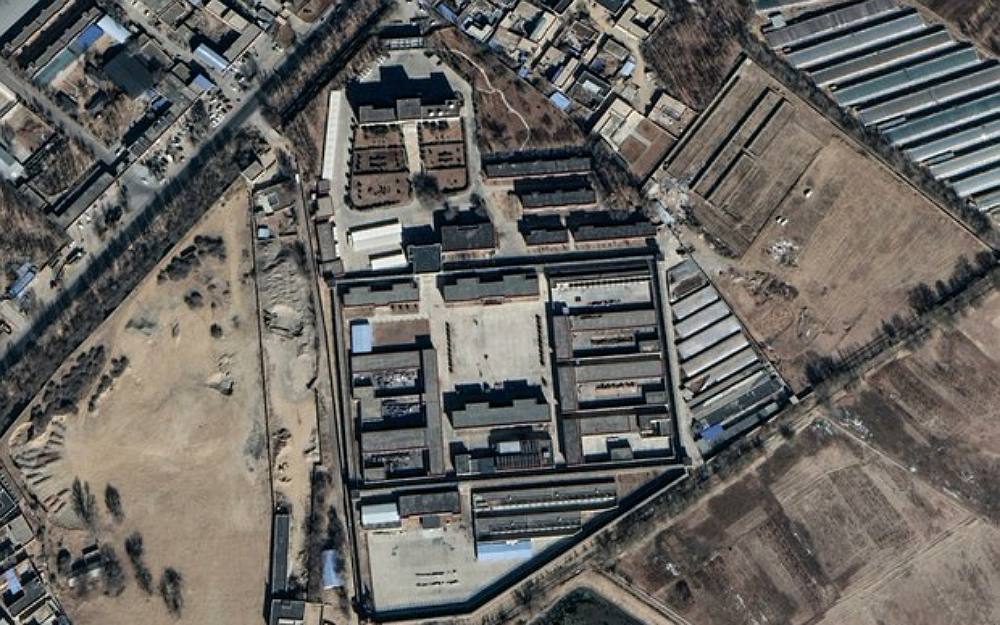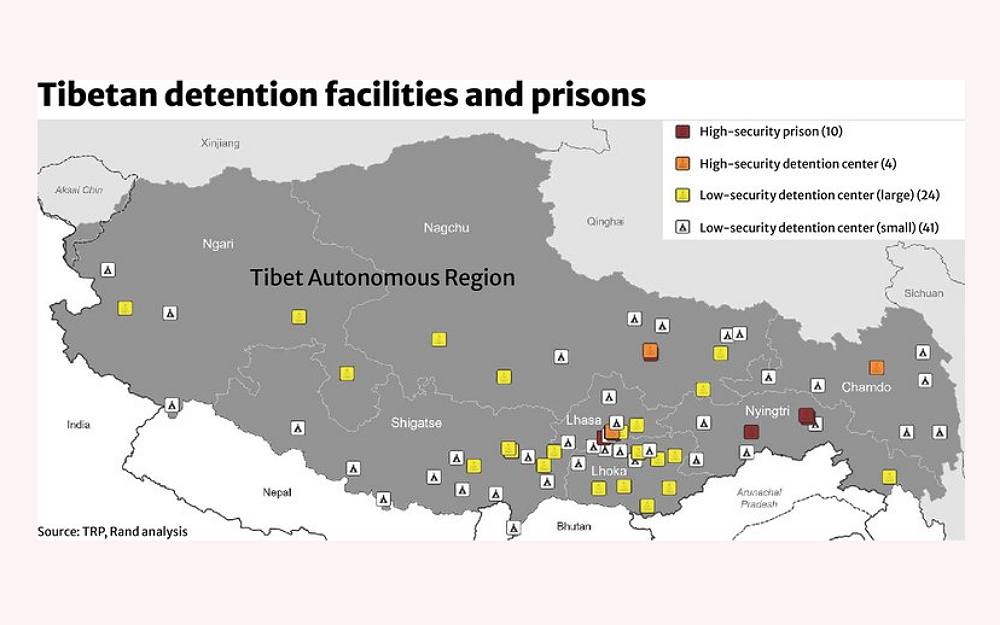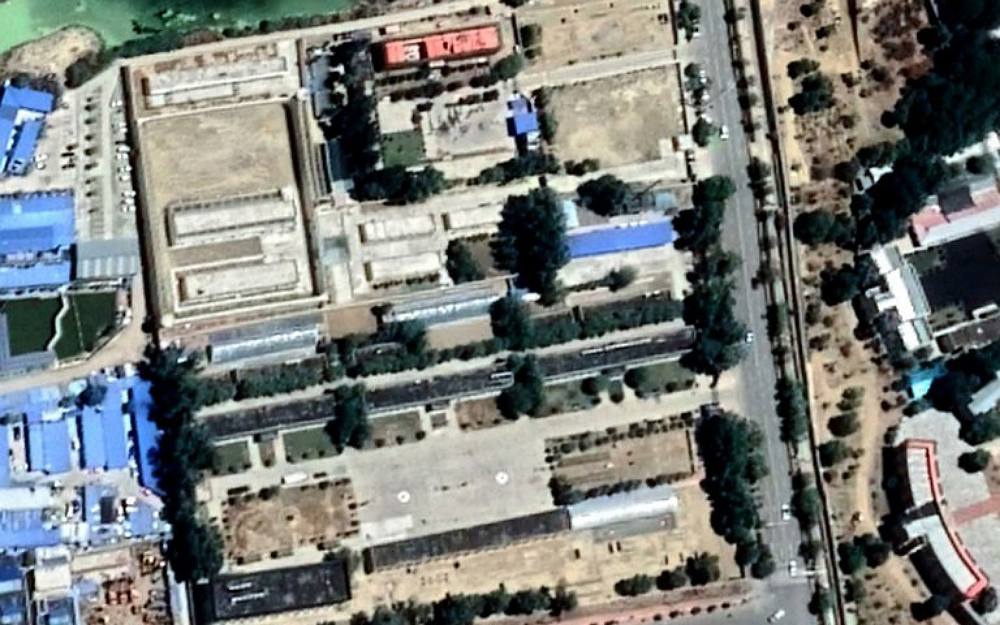Rand report sheds light on oppressive but poorly scrutinized mass arrests in the autonomous region.
By Tashi Wangchuk for RFA Tibet

When she was just 13, Ngawang Sangdrol was arrested for protesting Chinese Communist Party (CCP) rule in Tibet. She spent more than a decade in prison before international pressure led to her release in 2002.
Now an activist at the International Campaign for Tibet, her mission to draw attention to human rights abuses in her homeland like what she endured is complicated, she said, by China’s tight control over information in and out the region.
“Arbitrary detention and arrests take place in Tibet at a regular pace,” Ngawang told RFA. But “heavy restrictions” on communications – digital surveillance is widespread – makes it hard to tell the scope of the abuse, she added.
A study from Rand Europe, a research group, released this week sheds new light on the extent of China’s detention operations in Tibet – by measuring light from 79 sites in the region previously identified as detention centers of various security levels.
Rand researchers examined NASA satellite images from January 2014 until July 2022. While they believe that the number of prisons, jails and other detention facilities has remained the same over the past decade, they noticed that lighting at Tibet’s long-term, high security prisons “experienced a major period of growth in 2019 and 2020.”

The finding suggests a shift toward longer detentions as seen in Xinjiang against Uyghurs and other Muslim minority groups that have attracted greater international attention, the study says, although it adds that firm conclusions remain difficult.
“In both Tibet and Xinjiang, growth in night-time lighting has been concentrated in higher-security facilities, suggesting that in both regions there may be an increased emphasis on long-term imprisonment and detention of dissidents rather than shorter-term detention,” the report said.
The Chinese Embassy in Washington did not respond to a request for comment on the allegations by press time.
An information black hole
Rand chose to focus on light in part because there are few other options.
According to activists, Tibetans who speak out against alleged abuses face severe punishments. Tibetans have been detained for everything from communicating with foreigners to promoting Buddhist culture over Han teachings, a number of reports by the U.S. government and other entities have alleged.
But Rand said that information flows have become even more restricted as protocols put in place for COVID-19 made it harder for Tibetans to travel and as a system of surveillance has expanded.
Tibet is a “black hole” of information, said Ruth Harris, Rand Europe’s research director for defense and security.
Satellite imagery and nighttime analysis is an important methodology “for understanding what’s going on and to help policymakers to make good and informed decisions as much as they can,” Harris told RFA.

‘Stability maintenance’
Rand used a similar study lighting in 2021 to document what it called the “rapid, coordinated growth” of detention facilities in China’s Xinjiang region over the previous decade.
As many as 1.8 million Uyghurs and other Muslim minority groups are thought to have been detained by Chinese authorities. In a report last fall, the United Nations said it found allegations of torture and other severe human rights abuses to be credible and said they may constitute crimes against humanity.
China has called the allegations baseless.
Policies in Xinjiang and Tibet fall under China’s policy of “stability maintenance,” a post-Tiananmen euphemism for crackdown on dissent. But the broader world has a much better picture of what has transpired in Xinjiang than in Tibet even though Chinese authorities have conducted a similar campaign of “preventive repression” there, Rand said.
Rand used data by the Tibet Research Project, which had previously identified potential detention centers in the region, as the basis for its own report.
Most of the 79 facilities appear to have light security, indicating that they may be holding facilities used to detain people for a short period.
A call for more investigation
There are 14 facilities identified as higher security in Rand’s report on Tibet. The facilities have a larger footprint and at least three watchtowers.
Researchers noticed an increase in lighting in facilities in Ngari prefecture in Western Tibet Autonomous Region, as well as in Lhoka, Nagchu and Lhasa, the capital of the TAR.
The report lists a number of limitations in its findings. Little to no information exists on whether a facility has been decommissioned, or who is responsible for running particular detention centers, or the overall policies guiding their operations.
Conditions inside the facilities are largely unknown too.
“The precise workings, nature and scale of the CCP’s efforts to imprison and detain Tibetans currently remain poorly understood” and deserve greater study, the report states.
Sangdrol, a Buddist nun now in her 40s, said prisoners of her era endured brutal punishments during their incarceration. She’s heard tales of torture within the current prison system too, including through the use of electric batons.
But the group’s overarching finding – that the detention facilities remain active – didn’t come as a surprise to Sangdrol.
“The expansion of higher-security detention centers and prisons are very likely considering the number of people arrested and gone missing,” Sangdrol said.
Edited by Jim Snyder
Copyright © 1998-2020, RFA. Used with the permission of Radio Free Asia, 2025 M St. NW, Suite 300, Washington DC 20036. https://www.rfa.org.














